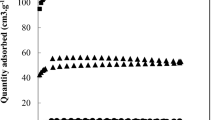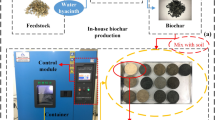Abstract
Purpose
Biochar addition to soils potentially affects various soil properties, and these effects are dependent on biochars derived from different feedstock materials and pyrolysis processes. The objective of this study was to investigate the effects of amendment of different biochars on soil physical and hydraulic properties.
Materials and methods
Biochars were produced with dairy manure and woodchip at temperatures of 300, 500, and 700 °C, respectively. Each biochar was mixed at 5 % (w/w) with a forest soil, and the mixture was incubated for 180 days, during which soil physical and hydraulic properties were measured.
Results and discussion
Results showed that the biochar addition significantly enhanced the formation of soil macroaggregates at the early incubation time. The biochar application significantly reduced soil bulk density, increased the amount of soil organic matter, and stimulated microbial activity at the early incubation stage. Saturated hydraulic conductivities of the soil with biochars, especially produced at high pyrolysis temperature, were higher than those without biochars on the sampling days. The treatments with woodchip biochars resulted in higher saturated hydraulic conductivities than the dairy manure biochar treatments. Biochar applications improved water retention capacity, with stronger effects by biochars produced at higher pyrolysis temperatures. At the same suction, the soil with woodchip biochars possessed higher water content than that with the dairy manure biochars.
Conclusions
Biochar addition significantly affected the soil physical and hydraulic properties. The effects were different with biochars derived from different feedstock materials and pyrolysis temperatures.






Similar content being viewed by others
References
Abiven S, Menasseri S, Chenu C (2009) The effects of organic inputs over time on soil aggregate stability—a literature analysis. Soil Biol Biochem 41:1–12
Adams WA (1973) The effect of organic matter on the bulk and true densities of some uncultivated podsoilc soils. J Soil Sci 24:11–17
Asai H, Samson BK, Stephan HM, Songyikhangsuthor K, Homma K, Kiyono Y, Inoue Y, Shiraiwa T, Horie T (2009) Biochar amendment techniques for upland rice production in Northern Laos 1. Soil physical properties, leaf SPAD and grain yield. Field Crop Res 111:81–84
Ayodele A, Oguntunde P, Joseph A, Souza Dias Junior M (2009) Numerical analysis of the impact of charcoal production on soil hydrological behavior, runoff response and erosion susceptibility. Rev Bras Ciênc Solo 33:137–145
Bagreev A, Bandosz TJ, Locke DC (2001) Pore structure and surface chemistry of adsorbents obtained by pyrolysis of sewage-derived fertilizer. Carbon 39:1971–1979
Bossuyt H, Denef K, Six J, Frey SD, Merckx R, Paustian K (2001) Influence of microbial populations and residue quality on aggregate stability. Appl Soil Ecol 16:195–208
Brewer R (1964) Fabric and mineral analysis of soils. John Wiley and Sons, New York
Brockhoff SR, Christians NE, Killorn RJ, Horton R, Davis DD (20100) Physical and mineral-nutrition properties of sand-based turfgrass root zones amended with biochar. Agro J 102:1627–1631
Brookes PC, Landman A, Pruden G, Jenkinson DS (1985) Chloroform fumigation and the release of soil nitrogen: a rapid direct extraction method to measure microbial biomass nitrogen in soil. Soil Biol Biochem 17:837–842
Brunauer S, Emmett PH, Teller J (1938) Adsorption of gases in multimolecular layers. J Am Chem Soc 60:309–319
Chen Y, Shinogi Y, Taira M (2010) Influence of biochar use on sugarcane growth, soil parameters, and groundwater quality. Aust J Soil Res 48:526–530
Downi A, Crosky A, Munroe P (2009) Physical properties of biochar. In: Lehmann J, Joseph S (eds) Biochar for environmental management: science and technology. Earthscan, London, pp 13–29
Dumroese KR, Heiskanen J, Englund K, Tervahauta A (2011) Pelleted biochar: chemical and physical properties show potential use as a substrate in container nurseries. Biomass Bioenergy 35:1–10
Glaser B, Lehmann J, Zech W (2002) Ameliorating physical and chemical properties of highly weathered soils in the tropics with charcoal—a review. Biol Fertil Soils 35:219–230
Jirku V, Kodesova R, Nikodem A, Muhlhanselova M, Zigova A (2013) Temporal variability of structure and hydraulic properties of topsoil of three soil types. Geoderma 204–205:43–58
Klute A (1986) Water retention: laboratory methods. In: Klute A (ed) Methods of soil analysis. Part 1. Physical and mineralogical methods. American Society of Agronomy, Madison, WI, pp 635–685
Klute A, Dirksen C (1986) Hydraulic conductivity and diffusivity: laboratory methods. In: Klute A (ed) Methods of soil analysis. Part 1. Physical and mineralogical methods. American Society of Agronomy, Madison, WI, pp 687–703
Kutílek M, Jenele L, Panayiotopoulos KP (2006) The influence of uniaxial compression upon pore size distribution in bi-model soils. Soil Tillage Res 86:27–37
Kuzyakov Y, Subbotina I, Chen H, Bogomolova I, Xu X (2009) Black carbon decomposition and incorporation into soil microbial biomass estimated by 14C labeling. Soil Biol Biochem 41:210–219
Laird DA, Fleming P, Davis DD, Horton R, Wang B, Karlen DL (2010) Impact of biochar amendments on the quality of a typical Midwestern agricultural soil. Geoderma 158:443–449
Lehmann J, da Silva JP Jr, Rondon MCM, Greenwood J, Nehls T, Steiner C, Glaser B (2002) Slash-and-char—a feasible alternative for soil fertility management in the Central Amazon. 17th World Congress of Soil Science, Bangkok
Lehmann J, Gaunt J, Rondon M (2006) Bio-char sequestration in terrestrial ecosystems—a review. Mitig Adapt Strat Gl Ch11:395–419
Liang B (2006) Black carbon increases cation exchange capacity in soils. Soil Sci Soc Am J 70:17–19
Liu Y, Yang M, Wu Y, Wang H, Chen Y, Wu W (2011) Reducing CH4 and CO2 emissions from waterlogged paddy soil with biochar. J Soils Sediments 11:930–939
Luo Y, Durenkamp M, Nobili MD, Lin Q, Brookes PC (2011) Short term soil priming effects and the mineralization of biochar following its incorporation to soils of different pH. Soil Biol Biogeochem 43:2304–2314
Major J, Lehmann J, Rondon M, Goodale C (2010) Fate of soil-applied black carbon: downward migration, leaching and soil respiration. Glob Chang Biol 16:1366–1397
McHenry MP (2009) Agricultural bio-char production, renewable energy generation and farm carbon sequestration in Western Australia: certainty, uncertainty and risk. Agric Ecosyst Environ 129(1–3):1–7
Miller JJ, Sweetland NJ, Chang C (2002) Hydrological properties of a clay loam soil after long term cattle manure application. J Environ Qual 31:989–996
Novak JM, Lima I, Xing B, Gaskin JW, Steiner C, Das KC, Ahmedna M, Rehrah D, Watts DW, Busscher WJ, Schomberg H (2009a) Characterization of designer biochar produced at different temperatures and their effects on a loamy sand. Ann Environ Sci 3:195–206
Novak JM, Busscher WJ, Laird DL, Ahmedna M, Watts DW, Niandou MAS (2009b) Impact of biochar amendment on fertility of a southeastern coastal plain soil. Soil Sci 174:105–112
Oades J (1984) Soil organic matter and structural stability: mechanisms and implications for management. Plant Soil 76:319–337
Obi ME, Ebo PO (1995) The effects of organic and inorganic amendments on soil physical properties and maize production in a severely degraded sandy soil in southern Nigeria. BioresourTechnol 51:117–123
Rawls WJ, Pachepsky YA, Ritchie JC, Sobecki TM, Bloodworth H (2003) Effect of soil organic carbon on soil water retention. Geoderma 116:61–76
Saxton KE, Rawls WJ (2006) Soil water characteristic estimates by texture and organic matter for hydrologic solutions. Soil Sci Soc Am J 70:1569–1578
Six J, Paustian K, Elliott ET, Combrink C (2000) Soil structure and organic matter: I. Distribution of aggregate-size classes and aggregate-associated carbon. Soil Sci Soc Am J 64:681–689
Six J, Bossuyt H, Degryze S, Denef K (2004) A history of research on the link between (micro) aggregates, soil biota, and soil organic matter dynamics. Soil Tillage Res 79:7–31
Spokas KA, Koskinen WC, Baker JM, Reicosky DC (2009) Impacts of woodchip biochar additions on greenhouse gas production and sorption/degradation of two herbicides in a Minnesota soil. Chemosphere 77:574–581
Tang J, Mo Y, Zhang J, Zhang R (2011) Influence of biological aggregating agents associated with microbial population on soil aggregate stability. Appl Soil Ecol 47:153–159
Tisdall JM, Oades JM (1982) Organic matter and water-stable aggregates in soils. J Soil Sci 33:141–163
Uzoma KC, Inoue M, Andry H, Fujimaki H, Zahoor A, Nishihara E (2011) Effect of cow manure biochar on maize productivity under sandy soil condition. Soil Use Manag 27:205–212
van Genuchten MT (1980) A closed form equation for predicting the hydraulic conductivity of unsaturated soils. Soil Sci Soc Am J 44:892–898
Vance ED, Brookes PC, Jenkinson DS (1987) An extraction method for measuring microbial biomass C. Soil Biol Biochem 19:703–704
Verheijen F, Jeffery S, Bastos AC, van der Velde M, Diafas I (2009) Biochar application to soils. A critical scientific review of effects on soil properties, processes and functions. Office for the Official Publications of the European Communities, Luxemburg
Zhang A, Bian R, Pan G, Cui L, Hussain Q, Li L, Zheng J, Zheng J, Zhang X, Han X, Yu X (2012) Effects of biochar amendment on soil quality, crop yield and greenhouse gas emission in a Chinese rice paddy: a field study of 2 consecutive rice growing cycles. Field Crop Res 127:153–160
Acknowledgments
This study was partly supported by grants from the Chinese National Natural Science Foundation (nos. 51179212 and 51039007).
Author information
Authors and Affiliations
Corresponding author
Additional information
Responsible editor: Rainer Horn
Rights and permissions
About this article
Cite this article
Lei, O., Zhang, R. Effects of biochars derived from different feedstocks and pyrolysis temperatures on soil physical and hydraulic properties. J Soils Sediments 13, 1561–1572 (2013). https://doi.org/10.1007/s11368-013-0738-7
Received:
Accepted:
Published:
Issue Date:
DOI: https://doi.org/10.1007/s11368-013-0738-7




